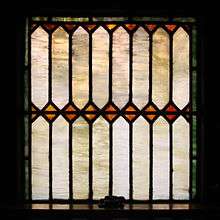St. Luke's United Methodist Church (Dubuque, Iowa)
|
St. Luke's Methodist Episcopal Church | |
 | |
  | |
| Location |
1199 Main St. Dubuque, Iowa |
|---|---|
| Coordinates | 42°30′14.4″N 90°40′8.4″W / 42.504000°N 90.669000°WCoordinates: 42°30′14.4″N 90°40′8.4″W / 42.504000°N 90.669000°W |
| Architect | George Kramer |
| Architectural style | Richardsonian Romanesque |
| NRHP Reference # | 98000387[1] |
| Added to NRHP | April 23, 1998 |
St. Luke's United Methodist Church, also known as St. Luke's Methodist and as St. Luke's United Methodist, is an historic Richardsonian Romanesque-style church located at 1199 Main Street in Dubuque, Iowa. It was added to the National Register of Historic Places on April 23, 1998. It is part of the Iowa Conference of the United Methodist Church.
The church has more Tiffany windows than any other church in the state.[2]
According to its NRHP nomination, the building is significant for its history in religion in Dubuque, for its Richardsonian Romanesque (unique in Dubuque), and for its Tiffany glass.[2]:15
National Register listing
- Historic Significance: Architecture/Engineering
- Architect, builder, or engineer: Tiffany Glass and Decorating Co., Kramer, George W.
- Architectural Style: Romanesque
- Area of Significance: Art, Architecture
- Period of Significance: 1875-1899
- Historic Function: Religion
- Historic Sub-function: Church Related Residence, Religious Structure
- Current Function: Commerce/Trade, Religion
- Current Sub-function: Professional, Religious Structure
History

The church can trace its origins back to the founding of the city of Dubuque, when Methodist Ministers arrived in the city and began work with the miners in the city.
The present church was built in 1896, and the congregation began worshiping in the building in 1897. The church is noted for the collection of Tiffany Stained glass windows. It has been called "one of the five finest Religious Tiffany collections in the world." The Angel in the window of the Angel among the Lilies is rumored to bear the likeness of the young deceased daughter of the people who had sponsored that particular window.
The pipe organ in the church is also of historic interest. When the Farand and Votey organ was purchased, two train cars were required to bring the parts to Dubuque. Because the train could not get across the river, barges than were used to float the parts over so that they could be installed in the church. The organ has about 1,000 pipes. At the time of installation, it was one of the largest organs in the area, however over the years it has been eclipsed by others. The pipe organ contains 36 ranks or pipes, about 2,200 total and was restored in 1992 by the Fowler Organ Company, Lansing, Mi.
See also
- St. Luke's Methodist Church (Monticello, Iowa), NRHP-listed, known also as St. Luke's United Methodist Church, in Jones County
References
- ↑ National Park Service (2007-01-23). "National Register Information System". National Register of Historic Places. National Park Service.
- 1 2 Helen Johnston (April 1997). "National Register of Historic Places Registration: St. Luke's United Methodist Church / St. Luke's Methodist / St. Luke's United Methodist" (PDF). National Park Service. Retrieved 2016-06-24. with photos